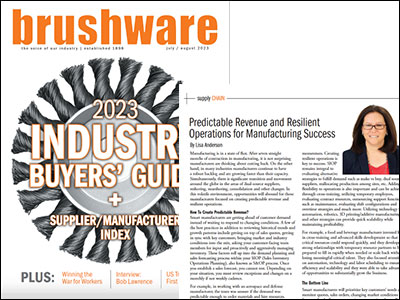Originally published in Brushware, July-August 2023
Manufacturing is in a state of flux. After seven straight months of contraction in manufacturing, it is not surprising manufacturers are thinking about cutting back. On the other hand, in many industries, manufacturers continue to have a robust backlog and are growing faster than their capacity. Simultaneously, there is significant transition and movement around the globe including dual source suppliers, reshoring, nearshoring, consolidation, and other changes. In this volatile environment, opportunities will abound for those manufacturers focused on creating predictable revenue and resilient operations.
How to create predictable revenue?
Smart manufacturers are getting ahead of customer demand instead of waiting to respond to changing conditions. A few of the best practices in addition to reviewing historical trends and growth patterns include getting on top of sales quotes, getting in sync with key customers, bringing market and industry conditions into the mix, and asking your customer facing team members for input. proactively and aggressively managing inventory. These factors roll up into the demand planning and sales forecasting process within your SIOP (Sales Inventory Operations Planning), also known as S&OP process. Once you establish a sales forecast, you cannot rest. Depending on your situation, you must review exceptions and changes on a monthly if not weekly cadence.
For example, in working with an aerospace and defense manufacturer, the team was unsure if the demand was predictable enough to order materials and hire resources. Thus, we analyzed data, collaborated with sales and marketing, reviewed customer portals, and evaluated historical trends with contracts. Although the team was uncomfortable, we didn’t enable analysis paralysis. Instead, we took the plunge and piloted forecasts with 70% confidence. The team’s success seemed in direct opposition to their discomfort as their forecast accuracy was one of the highest in almost 20 years of consulting. Most importantly, by creating predictable revenue, Operations had time to prepare. Customer service rates (OTD, on-time-in-full) shot up and costs went down. Margins improved by 5%.
How to create resilient operations?
Although having a directionally correct demand plan will provide an automatic boost in operational performance with solid leadership, it is no longer enough. To navigate volatility and prepare to take advantage of opportunities, manufacturers must be ready to scale on a dime or pull back without losing momentum. Creating resilient operations is key to success. SIOP remains integral to evaluating alternate strategies to fulfill demand such as make vs buy, dual source suppliers, reallocating production among sites, etc. Adding flexibility into operations is also important by cross-training, utilizing temporary employees, evaluating contract resources, outsourcing support functions such as maintenance, evaluating shift configurations and overtime strategies, and much more. Utilizing technology with automation, robotics, 3D printing/ additive manufacturing, and other strategies can provide quick scalability while maintaining profitability.
For example, a food and beverage manufacturer invested heavily in cross-training and advanced skills development so that critical resources could respond quickly, and they developed strong relationships with temporary resource partners to be prepared to fill in rapidly when needed or scale back without losing meaningful critical talent. They also focused attention on automation, technology, and labor scheduling to ensure efficiency and scalability, and they were able to take advantage of opportunities to substantially grow the business.
The bottom line
Smart manufacturers will prioritize key customers’ needs and monitor quotes, sales orders, changing market conditions, and forecast closely. From an operations perspective, they will create flexibility, resilience, scalability, and utilize technology to not only save money and create a superior customer experience but also to ensure rapid scalability and flexibility. Leverage SIOP, best practice demand planning processes and uncommon common sense operational programs to ensure manufacturing success.



